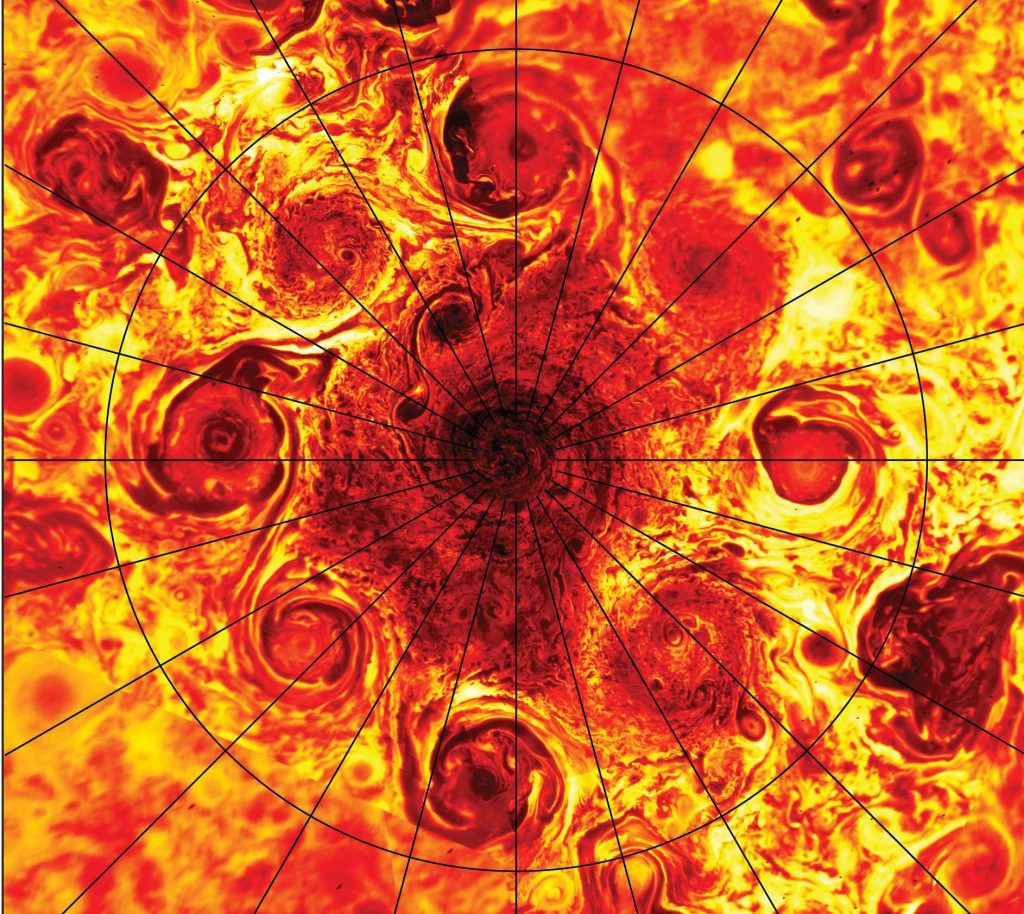
Jupiter, new mysteries revealed great hurricanes
Powerful hurricanes on Jupiter are very similar to the vortices of the oceans on Earth. Powerful hurricanes that originate in the atmosphere above the poles of Jupiter have much in common with eddies in Earth’s oceans. A discovery that reveals further details of the complex mystery that comprises this Jupiter phenomenon. The discovery was made thanks to a comparison of images of the polar vortices of Jupiter sent back by NASA’s Juno probe. With the marine circulation of the terrestrial oceans and the application of the principles of geophysical fluid dynamics, The researchers concluded that hurricanes on the largest planet in the solar system also produce and maintain convection, thanks to large masses of hot gas rising upward, then cooling and descending into the deeper layers of the atmosphere.
“When I saw the richness of the turmoil around Hurricanes Jovian with all its smaller threads and whirlpools, It reminded me of the turbulence that can be observed around the Earth’s oceanic vortices”Lia Siegelman, an oceanographer at the University of California, San Diego, first author of the study comments. “These characteristics – he notes – are particularly evident, for example, in high-resolution satellite images of plankton flowers.” Siegelman thinks they understand The work of Jupiter’s energy system, on a much larger scale than that of the Earth, can help us improve our knowledge of the physical mechanisms at play on our planet., highlighting some of the energy transfer processes that can also occur on Earth.
Juno is the first spacecraft to take pictures of Jupiter’s poles; Her ancestors revolved around the equatorial region of the planet. Juno is equipped with two camera systems: one for visible light imagery, JunoCam, and one for thermal image capture, the Jovian Infrared Auroral Mapper (Jiram), the latter led by ASI and scientific responsibility for INAF. The team analyzed a series of infrared images obtained from jiram
From the region around the north pole of Jupiter, and in particular the set of polar vortices centered there. From the images, the researchers were able to calculate wind speed and direction by observing the movement of clouds in a sequence of images. Next, the team interpreted the infrared images and provided an estimate of the cloud’s thickness. In warmer regions there are thin clouds, where the atmosphere of Jupiter can be seen at greater depth. On the other hand, cold regions show a thick blanket of clouds that protects Jupiter’s atmosphere.
These results provided the researchers with clues to the energy of the Jovian atmosphere system. The researchers found that atmospheric gases The rapid rise within the clouds is the source of energy that triggers and sustains large polar and polar cyclones. Juno arrived around the Jupiter system in 2016, to provide scientists for the first time with a comprehensive and detailed view of the great polar cyclones in the planet’s atmosphere. The radius of these giant structures is about 2000 km. Eight of these cyclones are at the north pole of Jupiter and five are over the south pole, and have maintained a fairly stable composition since their discovery five years ago. “We’re not yet sure how these polar vortices originated or how long they lasted, but we now know that this humid convection is what underpins them,” notes National Institute of Tropical Agriculture researcher Alessandro Mora, study co-author and scientific director of the JERAM instrument.
The study relied on a series of Jerram images of exceptional quality in terms of accuracy and spatial coverage. This quality was made possible by careful planning of the observations made by the Italian scientific team, “stresses Christina Blainaki, a researcher in solar system sciences, and the Asi project scientist on the Jiram/Juno experiment.” In this way – continues Plainaki – it was not only possible to determine the typical values of wind speeds within the polar vortices but also to study the specific properties of spatial distributions. This has profound implications for the nature of the phenomena that occur there, particularly related to convection and turbulence. Siegelman’s study, also due to the extensive use of exemplary methods of terrestrial oceanography, certainly stands out in Jupiter science for its originality and depth of interpretation.”
“This study puts another piece into the intriguing puzzle behind the mysterious polar cyclones of Jupiter.” Confirms Giuseppe Cendoni, head of the Juno-Jeram project for Assi. “He adds that the data provided by our tool has once again proven essential in explaining the complex phenomena of Joe Jovian.” Juno’s mission will continue to orbit Jupiter until 2025, providing us with new images of the planet and its vast lunar system and helping scientists study it more accurately. The study was published today on the website of the journal Nature Physics In the article, Wet Convection Drives Sublime Energy Transfer at High Jovian Latitudes by Lea Siegelman, Patrice Klein, Andrew B. Ingersoll, Sean B. Ewald, and William R. and Giuseppe Cendone.

“Incurable web evangelist. Hipster-friendly gamer. Award-winning entrepreneur. Falls down a lot.”
